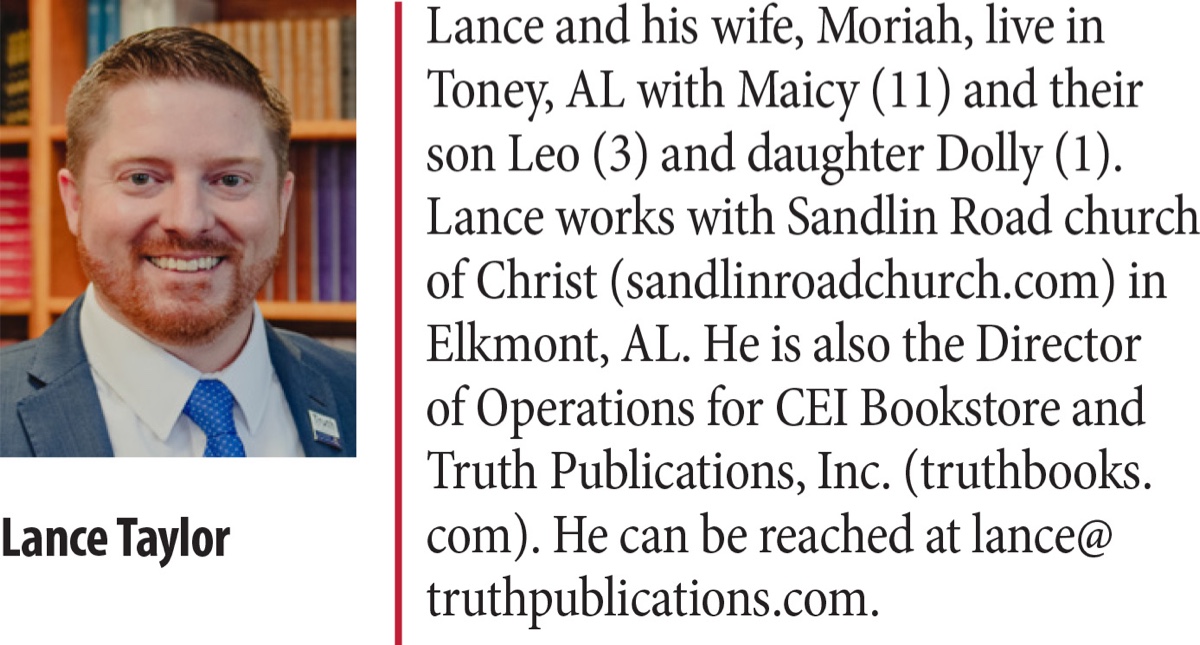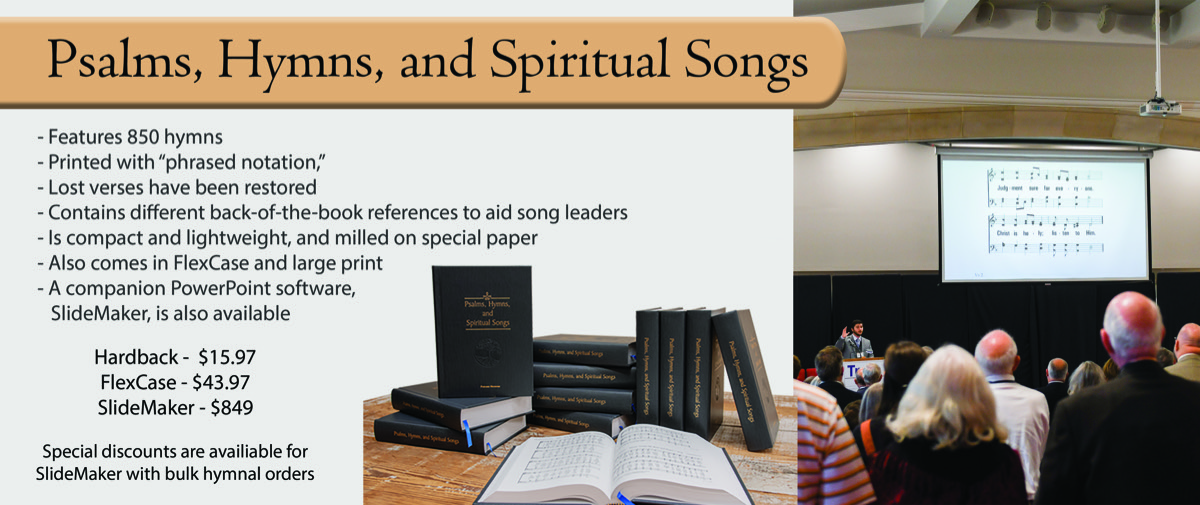By Lance Taylor
Synopsis: Using digital products and media platforms can enhance the worship and work of the Lord’s church today.
In recent times, worship has been re-examined and addressed in diverse ways because of unforeseen circumstances that brethren had not previously experienced in the current era. The digital age has been upon us for many years, but that reality hit hyper-speed when the 2020 pandemic began. Suddenly, congregations and their leadership faced obstacles in direct conflict with assembling together.
Prior to the pandemic, many congregations had implemented digital products and digital media into their regular worship and ministry. Products like Slide Maker hymn slide software were already widely in accompaniment with the hymnals in the pews to display the hymns on large screens for the assembly to sing from instead of using the hymnal alone. This digital enhancement was being recognized by everyone who had experienced it to be a wonderful way to better engage the congregation in singing. Why? Because now, everyone helping with small children during the singing did not need to wrestle with a hymnal and a child at the same time. Because those with hearing disability could see the song number and information for every selection. Because the congregation raised their faces up toward the song leader, producing more sound throughout the assembly and a better following of the leader. Because members who had technical talents could now serve the Lord’s church in new and beneficial ways.
Singing wasn’t the only part of worship already being enhanced by digital developments. Scriptures for reading were being placed on the screen. Sermon outlines and notes were being effectively displayed via PowerPoint and Keynote programs—replacing the overheads and whiteboards of old. Many, if not most, congregations had websites and other media platforms in place where the audio and video files of sermons could be uploaded following the services for sharing and reviewing later.
So, what changed in 2020 and beyond? The pandemic presented the never-experienced obstacle of simply not being able to meet together in the same place. This health concern placed significant burdens upon shepherds to decide how to continue to worship in such challenging times. In order to continue worshiping through the COVID-19 pandemic, many congregations began live-streaming their worship services for the first time. Churches began using digital technologies in various ways. It has been a time of swift transition.
Texas A&M University produced an article in late 2021 in response to a study entitled, “When Churches Closed, Religious Leaders Turned to Tech.” Caitlin Clark examines how the COVID-19 pandemic forced houses of worship that closed their doors to adapt to digital media and provide services online in new, engaging ways.
This article, and the related full study cited below, provides interesting reading when we consider the overall impact and subsequent transitions made by the religious world at large because of the challenges presented by the pandemic. Such studies offer snapshots of the reality that has confronted us all.
The Greek philosopher, Heraclitus, is credited with the saying, “change is the only constant in life.” It is frequently shortened to “the only constant is change.” Heraclitus lived in Ephesus around 500 BC. What was changing then, we might scoffingly ask, “Chariot designs?” Today’s changes are far greater and more rapid than anything that could have been occurring in 500 BC. However, those who lived in the time of Heraclitus experienced changes that were just as real as what we are experiencing now. Without question, those living in 500 BC could run off a list of changes of significant impact to their lives, families, and worship just as quickly as we can list them today.
Even in the last 100 years, we can reference many changes that have enhanced the worship of the Lord’s church. Please note, we are not speaking of unscriptural changes in worship, but ways in which our ability to engage in scriptural worship has been enhanced. The Bible became readily available, not just in English, but in a variety of languages and dialects. Hymnals have grown in content and availability with modern printing. Transportation to assemblies has advanced from walking or riding wagons on rutted roads to comfortable, air-conditioned automobiles gliding along paved highways—making it possible for Christians to attend worship services at distant locations.
In the last seventy-five years, there have been constantly growing publications of Bible study and reference materials to aid in the growth and ministry of the church. Think about the books and materials that are used today by almost every congregation that were not even available before 1950 or 1985 or 2000 or 2010! Vacation Bible Schools, children’s curriculum, lessons useful for new converts, commentaries, correspondence courses, outreach and mission materials, systematic study guides of the Bible, and on and on.
Not to mention electricity, air conditioning, indoor plumbing, microphones and audio speakers, baptistries, security systems, and so many other beneficial advances. Now, all of that really is to get to this main point. Digital products and digital media platforms represent a set of new tools available today that can enhance the worship and work of the Lord’s church.
In his research and discoveries, Johann Kepler (1571-1630), the eminent scientist, said he was merely “thinking God’s thoughts after Him.” He was exactly right. We are simply uncovering the wisdom and knowledge of God in the advances that occur in the modern world. Is digital media new? Perhaps to us, but not to God. Did PowerPoint presentations surprise God? Did Bluetooth connectivity surprise God? Did 4K video feeds surprise God? Obviously and unequivocally, no! God provided all the raw materials and required components that make their existence possible. By creating man in His own image, God supplied us with intellect and creativity that leads to technological changes.
With God’s given bounds of possibilities, we have arrived at a place where, when many of us look across the assembly of saints, we see as many digital devices used to read Sacred Scripture as we see hard copy Bibles in hand. Is the Bible still being used and read? Yes. Is our ability to engage in effective study enhanced because of the search features and shortcuts and reference helps offered by digital Bible study apps? Yes, although I miss hearing the rustling of pages as occurred during past sermons.
With God’s possibilities, we have arrived at a place where the Bible can be taught personally in real time across the globe and locally by programs like Zoom and Skype.
With God’s possibilities, we have arrived at a place where the lessons of faithful teachers and preachers are preserved in written, audio, and video form for future generations to access.
It is with these same God-provided possibilities we are at the place and time where digital products and digital media platforms are available and easily usable in worship and ministry.
At Truth Publications, we now offer every published book in digital form besides the hard copy edition. We offer “Class-Use Purchase Rights” to digital products, allowing the users to share enough copies for their class to use on personal digital devices. We offer the Slide Maker software for displaying the hymns from our hymnal, Psalms, Hymns, and Spiritual Songs. All these digital products grew in popularity, demand, and usage since the challenges of 2020.
Zacchaeus was short in stature and needed to “find a tree” in order to see Jesus. In recent years, we climbed digital “trees” to rise above the obstacles in the world and continue to worship and serve God faithfully.
Live-streaming worship, so that members could meet virtually, was one of those digital trees that many of us climbed. One significant question arising from that time has been, “Will we continue to offer live streaming in a post-pandemic time?” From various research and surveys, the verdict still seems to be out on that question overall. The Texas A&M article previously referenced stated that two-thirds of churches would continue with streaming services post-pandemic—making the claim that it is here to stay as a part of worship practice in the future.
There are many things to consider with live streaming worship. Will it deter members from ever returning to in-person worship? Will it lead to burnout among those who are tasked with the technical operations involved? What are we responsible for with copyrights and licensing?
Obviously, worshipping “face-to-face” and “in-person” is vastly superior to virtual arrangements. (Please see the theme section of the July 2022 issue of Truth Magazine for additional articles on this point.) Virtual arrangement can be beneficial, so long as it doesn’t become a crutch or an excuse. In weighing all these factors, may I encourage a simple answer and reminder when considering such questions? Elders must faithfully and scripturally make the leading decisions for the congregation entrusted to them.
In Acts 14:23, we read, “So when they had appointed elders in every church, and prayed with fasting, they commended them to the Lord in whom they had believed.” This occurred as Paul and Barnabas were making their way back through churches they had earlier established—-strengthening converts in newly discipled cities. Assuming there are qualified men, elders should be found in every church. Why? To shepherd and rule the local congregations of God’s people.
Peter said this to elders in 1 Peter 5:2-4,
Shepherd the flock of God which is among you, not by compulsion but willingly, not for dishonest gain but eagerly; nor as being lords over those entrusted to you, but being examples to the flock; and when the Chief Shepherd appears, you will receive the crown of glory that does not fade away.
Digital products and digital media platforms are not found in the Scriptures specifically. Neither are modern bound Bibles, hymnals, PowerPoint, microphones, audio speakers, video cameras, websites and the like. So, we must use all the above within the bounds of God-directed worship and ministry. We must hold up the hands of our elderships as they prayerfully decide how to use (or not use) these enhancements and tools for worship and ministry.
As Peter said in 1 Peter 4:11 “. . .that in all things God may be glorified through Jesus Christ, to whom belong the glory and the dominion forever and ever. Amen.”—this should be our attitude and purpose when thinking about how to choose and use digital products and digital media in worship.
In closing, here are a few quick dos and don’ts from my experience:
Use good quality audio in any efforts to stream your worship. Test the microphone and adjust the audio levels as needed. Be considerate of the online viewer/listener.
You don’t need to spend thousands of dollars on cameras. The camera on an iPhone may surprise you when it comes to live streaming quality. PTZ (Pan, Tilt, Zoom) cameras are nice and will allow for flexibility in screenshots, but “movie” quality cameras are not a necessity.
Encourage your worship leaders to be aware of those viewing online. Speak clearly, explain what is being done in the order of service, do not assume that everyone knows everything “we usually do” in worship.
Don’t make personal, local announcements to the entire world online without the consent of those involved.
Do lead worship, preach, read, teach, sing, etc. as if the entire world is watching, and the auditorium is completely full!
Approaching worship in this way will improve our offering of service to the congregation and to the Lord! Regardless of whether your congregation streams online, this focus of offering the best to God will benefit you and those of your local congregation.
I would much rather preach to a full auditorium than to a camera alone at a desk, but when we preach, no matter what the arena, we proclaim the greatest message ever to be told. When we preach into a camera for streaming or uploading online, we are potentially speaking to an audience far larger than any auditorium could ever hold.
Don’t shun digital products and media just because they are new. Look at the school-age generation around you. They are all learning more by using digital devices than by using printed books. If we can teach and train them up better digitally, then why not?
Commit to “being the church” in all uses of digital content. Don’t just focus on who is “going to church” as we sometimes say innocently. If we are being the church in the way we use and share in-person and digital content, then we will be lights in the world as Christ has instructed.
Seek the engagement of everyone in worship. Whether streaming or not, worship is participatory, not a production or performance of which to be a spectator. If you are steaming, find a way to engage with the online participant.
Do give ways to connect, to receive study and class materials, to share in communion, to give their monetary offering remotely, encourage them to sing with you, to open their Bible, to join in prayer.
Campbell, Heidi A. and Sophia Osteen. “When Pastors Put on the ‘Tech Hat’: How Churches Digitized during Covid-19,” Report 1: Analyzing Churches Engagement with Technology During the Covid-19 Pandemic, November 2021, 28.
Clark, Caitlin. “When Churches Closed, Religious Leaders Turned To Tech.” Texas A&M Today, December 20, 2021. https://today.tamu.edu/2021/12/20/when-churches-closed-religious-leaders-turned-to-tech/.



